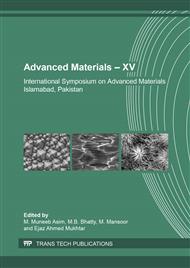[1]
V. Eswaraiah, K. Balasubramaniam, and S. Ramaprabhu, Functionalized graphene reinforced thermoplastic nanocomposites as strain sensors in structural health monitoring. J. Mater. Chem., 21 (2011) 34.
DOI: 10.1039/c1jm12302e
Google Scholar
[2]
Z. Lou, S. Chen, L. Wang, K. Jiang, and G. Shen, An ultra-sensitive and rapid response speed graphene pressure sensor for electronic skin and health monitoring. Nano Ener., 23 (2016) 7–14.
DOI: 10.1016/j.nanoen.2016.02.053
Google Scholar
[3]
C. S. Boland, U. Khan, C. Backes, A.O'Neill, J. McCauley, et al., Sensitive, High-Strain, High-Rate Bodily Motion Sensors Based on Graphene–Rubber Composites. ACS Nano, 8 (2014) 8819–8830.
DOI: 10.1021/nn503454h
Google Scholar
[4]
C.Yan, J. Wang, W. Kang, M. Cui, X. Wang, et al. (2014). Highly Stretchable Piezoresistive Graphene–Nanocellulose Nanopaper for Strain Sensors. Adv. Mater., 26 (2014) (2022).
DOI: 10.1002/adma.201470083
Google Scholar
[5]
S. H. Bae, Y. Lee, B. K. Sharma, H. J. Lee, J. H. Kim, et al., Graphene-based transparent strain sensor. Carbon, 51(2013) 236–242.
DOI: 10.1016/j.carbon.2012.08.048
Google Scholar
[6]
I. Kang, M. J. Schulz, J. H. Kim, V. Shanov, and D. Shi, A carbon nanotube strain sensor for structural health monitoring. Smart Mater. Struct., 15 (2006) 737.
DOI: 10.1088/0964-1726/15/3/009
Google Scholar
[7]
J. Zhao, C. He, R. Yang, Z. Shi, M. Cheng, et al., Ultra-sensitive strain sensors based on piezoresistive nanographene films. Appl. Phy. Lett., 101 (2012) 63112.
DOI: 10.1063/1.4742331
Google Scholar
[8]
X. Xiao, L. Yuan, J. Zhong, T. Ding, Y. Liu, et al. (2011). High-Strain Sensors Based on ZnO Nanowire/Polystyrene Hybridized Flexible Films. Adv. Mater., 23 (2011) 5440.
DOI: 10.1002/adma.201103406
Google Scholar
[9]
J. Zhou, Y. Gu, P. Fei, W. Mai, Y. Gao, et al., Flexible Piezotronic Strain Sensor. Nano Lett., 8 (2008) 3035–3040.
DOI: 10.1021/nl802367t
Google Scholar
[10]
J. Cao, Q. Wang and H. Dai. Electromechanical Properties of Metallic, Quasimetallic, and Semiconducting Carbon Nanotubes under Stretching. Phys. Rev. Lett., 90 (2003) 157601.
DOI: 10.1103/physrevlett.90.157601
Google Scholar
[11]
M. Amjadi, A. Pichitpajongkit, S. Lee, S. Ryu and I. Park. Highly Stretchable and Sensitive Strain Sensor Based on Silver-Elastomer Nanocomposite. ACS Nano, 8(2014), 5154–5163.
DOI: 10.1021/nn501204t
Google Scholar
[12]
A. Nakamura, T. Hamanishi, S. Kawakami and M. Takeda. A piezo-resistive graphene strain sensor with a hollow cylindrical geometry. Mater. Sci. Engineer. B: Solid-State Materials for Adv. Technol., 219 (2017) 20–27.
DOI: 10.1016/j.mseb.2017.02.012
Google Scholar
[13]
M. F. El-Kady, V. Strong, S. Dubin and R. B. Kaner. Laser Scribing of High-Performance and Flexible Graphene-Based Electrochemical Capacitors. Sci., 335 (2012) 1326-1330.
DOI: 10.1126/science.1216744
Google Scholar
[14]
M. Schumann, R. Sauerbrey and M.C. Smayling. Permanent increase of the electrical conductivity of polymers induced by ultraviolet laser radiation. Appl. Phy. Lett., 58 (1991) 428–430.
DOI: 10.1063/1.104624
Google Scholar
[15]
J. Lin, Z. Peng, Y. Liu, F. Ruiz-Zepeda, R. Ye, et al. Laser-induced porous graphene films from commercial polymers. Nat. Commun., 5 (2014) 1–8.
DOI: 10.1038/ncomms6714
Google Scholar
[16]
L.-Q. Tao, H. Tian, Y. Liu, Z.-Y. Ju, Y. Pang, et al. An intelligent artificial throat with sound-sensing ability based on laser induced graphene. Nat. Communicat., 8 (2017) 14579.
DOI: 10.1038/ncomms14579
Google Scholar
[17]
H. Tian, Y. Shu, X.-F. Wang, M.A. Mohammad, Z. Bie, et al. A graphene-based resistive pressure sensor with record-high sensitivity in a wide pressure range. Scientif. Rep., 5 (2015) 8603.
DOI: 10.1038/srep08603
Google Scholar
[18]
H. Tian, Y. Shu, Y.-L. Cui, W.-T. Mi, Y. Yang, et al. Scalable fabrication of high-performance and flexible graphene strain sensors. Nanoscale, 6 (2014) 699–705.
DOI: 10.1039/c3nr04521h
Google Scholar
[19]
D. C. Marcano, D. V Kosynkin, J. M. Berlin, A. Sinitskii, Z. Sun, et al. (2010). Improved Synthesis of Graphene Oxide. ACS Nano, 4 (2010) 4806–4814.
DOI: 10.1021/nn1006368
Google Scholar
[20]
M. Gamil, H. Nageh, I. Bkrey, S. Sayed, A. M. F. El-Bab, K. Nakamura, et al. Graphene-based strain gauge on a flexible substrate. Sens. Mater., 26 (2014) 699-709.
Google Scholar
[21]
Z. Fan, K. Wang, T. Wei, J. Yan, L. Song, and B. Shao, An environmentally friendly and efficient route for the reduction of graphene oxide by aluminum powder. Carbon, 48 (2010) 1686–1689.
DOI: 10.1016/j.carbon.2009.12.063
Google Scholar
[22]
R. Kumar, R.K. Singh, D.P. Singh, E. Joanni, R.M. Yadav, and S.A. Moshkalev, (2017). Laser-assisted synthesis, reduction and micro-patterning of graphene: Rec. prog. Appli., Coordi. Chem. Rev. (Supplement C), 342 (2017) 34–79.
DOI: 10.1016/j.ccr.2017.03.021
Google Scholar
[23]
D.Y. Wang, L.-Q. Tao, Y. Liu, T.-Y. Zhang, Y. Pang, et al. High performance flexible strain sensor based on self-locked overlapping graphene sheets. Nanoscale, 8 (2016) 20090–20095.
DOI: 10.1039/c6nr07620c
Google Scholar


